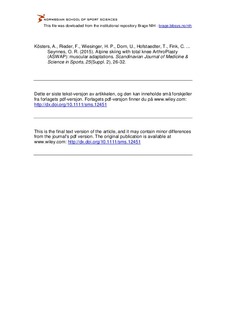| dc.contributor.author | Rieder, Florian | |
| dc.contributor.author | Kösters, Alexander | |
| dc.contributor.author | Wiesinger, Hans-Peter | |
| dc.contributor.author | Dorn, U. | |
| dc.contributor.author | Hofstaedter, T. | |
| dc.contributor.author | Fink, Christian | |
| dc.contributor.author | Müller, Erich | |
| dc.contributor.author | Seynnes, Olivier R. | |
| dc.date.accessioned | 2016-02-02T09:54:44Z | |
| dc.date.available | 2016-02-02T09:54:44Z | |
| dc.date.issued | 2015-06-17 | |
| dc.identifier.citation | Scandinavian Journal of Medicine & Science in Sports. 2015, 25, 26–32 | nb_NO |
| dc.identifier.uri | http://hdl.handle.net/11250/2375631 | |
| dc.description | I Brage finner du siste tekst-versjon av artikkelen, og den kan inneholde ubetydelige forskjeller fra forlagets pdf-versjon. Forlagets pdf-versjon finner du på onlinelibrary.wiley.com: http://dx.doi.org/10.1111/sms.12451 / In Brage you'll find the final text version of the article, and it may contain insignificant differences from the journal's pdf version. The definitive version is available at onlinelibrary.wiley.com: http://dx.doi.org/10.1111/sms.12451 | nb_NO |
| dc.description.abstract | This study investigated the effectiveness of recreational skiing as an intervention to improve quadriceps muscle architecture, strength, and antagonistic co-activation in patients with unilateral total knee arthroplasty (TKA). Hence, patients with TKA were assigned to either an intervention group (IG) or control group (CG). The IG completed a 12-week guided skiing program whereas the CG was instructed not to change their daily routines for the same period and was not allowed to ski. Before, after the intervention/after an 8-week retention period m. rectus femoris (RF) cross-sectional area (CSA), m. vastus lateralis muscle thickness, fascicle length, and pennation angle were measured with ultrasonography, while isometric (90° knee angle) knee extension, flexion torque and m. biceps femoris co-activation were assessed on an isokinetic dynamometer in 26 patients. There were significant and stable increases in RF CSA for the operated (10%; P < 0.05) and non-operated leg (12%; P < 0.01) after the training period in the IG whereas no changes were observed for the CG (all P > 0.05). There were no significant effects for other parameters (all P > 0.05). Overall, the skiing intervention was successful in increasing muscle mass in TKA older patients. | nb_NO |
| dc.language.iso | eng | nb_NO |
| dc.publisher | John Wiley & Sons Ltd | nb_NO |
| dc.subject | strength | nb_NO |
| dc.subject | muscle weakness | nb_NO |
| dc.subject | aging | nb_NO |
| dc.subject | sarcopenia | nb_NO |
| dc.title | Alpine skiing with total knee arthroplasty (ASWAP): muscular adaptations | nb_NO |
| dc.type | Journal article | nb_NO |
| dc.type | Peer reviewed | nb_NO |
| dc.subject.nsi | VDP::Social science: 200 | nb_NO |
| dc.subject.nsi | VDP::Social science: 200::Social science in sports: 330 | nb_NO |
| dc.subject.nsi | VDP::Social science: 200::Social science in sports: 330::Other subjects within physical education: 339 | nb_NO |
| dc.source.journal | Scandinavian Journal of Medicine & Science in Sports | nb_NO |
| dc.identifier.doi | 10.1111/sms.12451 | |
| dc.description.localcode | Seksjon for fysisk prestasjonsevne / Department of Physical Performance | nb_NO |
